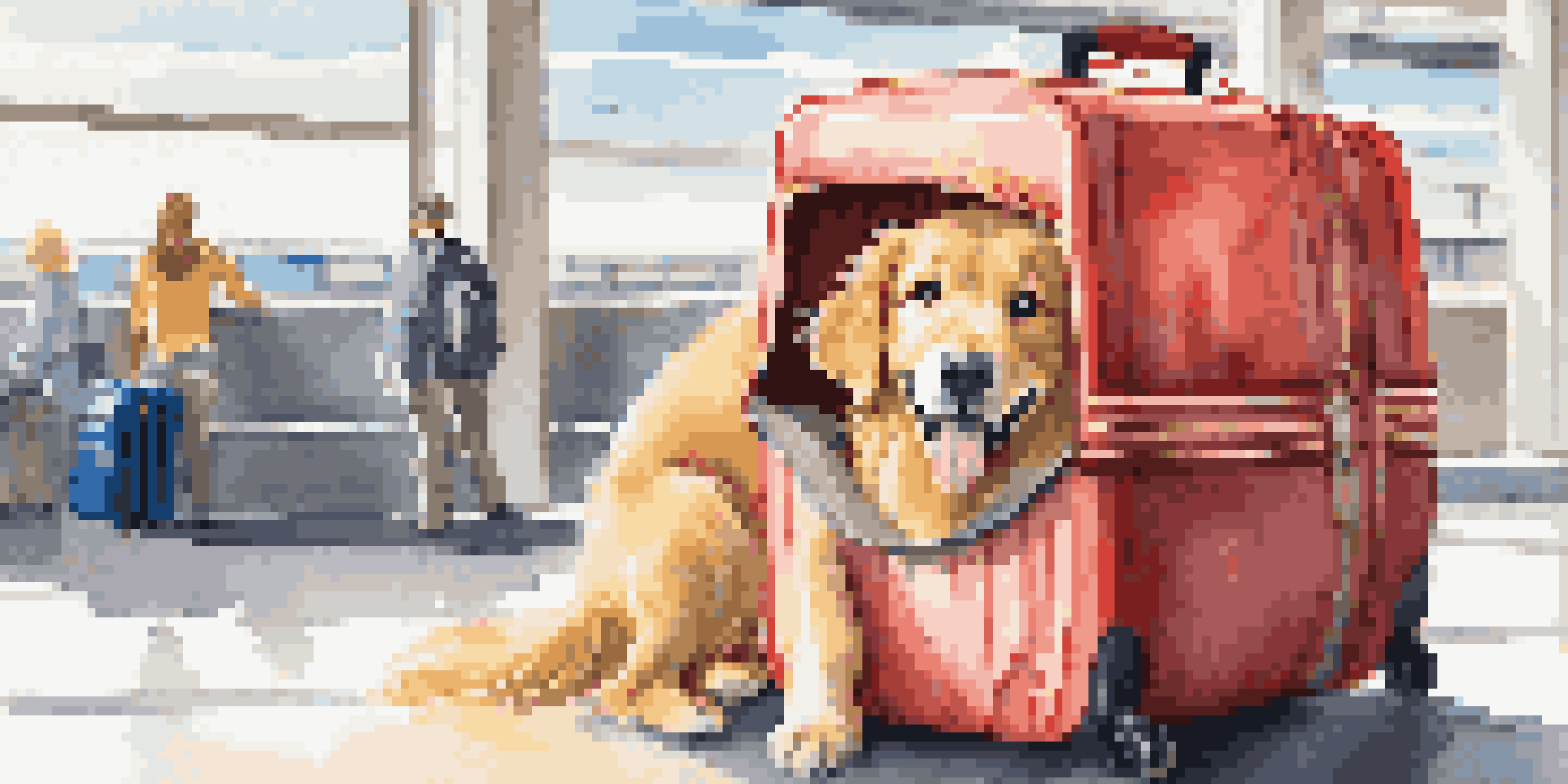Navigating Pet Policies for Airlines and Train Travel

Understanding the Basics of Pet Travel Policies
Traveling with your pet can be a delightful experience, but it’s crucial to know the basics of pet travel policies. Airlines and train companies have specific rules regarding pet travel, which can vary significantly. Understanding these policies helps you prepare for a smooth journey, ensuring your furry friend is safe and comfortable.
Traveling with pets is a journey of its own, filled with adventure and the need for preparation.
Before booking your travel, take the time to research the specific airline or train service you plan to use. Some companies allow pets in the cabin, while others may require them to travel in a cargo hold. Additionally, each service may have different weight limits, carrier specifications, and breed restrictions, making it essential to familiarize yourself with these details.
Always check for any health requirements or documentation needed for your pet before traveling. This can include vaccination records or health certificates, which some companies may require. Knowing these details can save you from unexpected surprises on travel day!
Airlines: Key Considerations for Pet Travel
When flying with your pet, airlines often have specific rules about in-cabin travel versus cargo. Many airlines permit small dogs and cats to travel in the cabin if they fit in an approved carrier under the seat. However, larger pets usually need to be transported in the cargo area, which can be stressful for both the pet and owner.

It’s important to book your flight early, as airlines often have a limited number of spots for pets in the cabin. Additionally, the time of year can affect pet travel; extreme temperatures can lead to restrictions on pet travel in cargo. Make sure to plan your trip during milder months if possible, to keep your pet safe.
Post-Travel Care Matters
Allow your pet time to adjust and maintain their routine to help them settle into a new environment.
Lastly, reach out to the airline ahead of time to confirm their pet policy and any fees associated. Some airlines charge a fee for pets traveling in the cabin, while others may have different costs for cargo travel. Having all this information organized will help ease your travel experience.
Train Travel: Unique Pet Policies to Know
Traveling by train can be a great alternative to flying, especially for pets. Many train services, like Amtrak, allow pets to travel in designated areas, but there are specific rules to follow. Generally, only small pets are allowed, and they must remain in their carriers for the duration of the journey.
The greatness of a nation can be judged by the way its animals are treated.
One key difference with train travel is that pets often travel for a lower fee compared to airlines. However, you still need to check the restrictions, such as the number of pets per passenger and the size of carriers allowed. This can make train travel a more budget-friendly option for pet owners.
When planning your train trip, be sure to familiarize yourself with the boarding process and any waiting areas designated for pet owners. This can help you feel more prepared when you arrive at the station, ensuring a smoother experience for both you and your pet.
Preparing Your Pet for Travel
Before embarking on your journey, it’s essential to prepare your pet for travel. This can start with acclimating them to their travel carrier so they feel comfortable and secure during the trip. You can do this by letting them explore the carrier at home and rewarding them for spending time inside.
Another great step is to schedule a visit to the vet prior to travel. A wellness check can help ensure your pet is healthy enough for the trip, and you can address any potential travel concerns. Additionally, your vet can provide you with health certificates or medications for anxiety if needed.
Know Pet Travel Policies
Research airline and train policies before traveling to ensure your pet's safety and comfort.
Don’t forget to pack essential items for your pet, such as food, water, a leash, and any favorite toys. Having familiar items can help reduce stress for your pet and make them feel more at ease during your journey.
Travel Day: Tips for a Smooth Experience
On travel day, it’s important to arrive early to give yourself plenty of time to navigate check-in and security procedures. Whether flying or taking the train, you’ll want to factor in extra time for your pet’s needs. This means bathroom breaks and ensuring your pet is settled in their carrier before the journey begins.
Keep your pet calm by talking to them in a soothing voice and having treats on hand to reward them for good behavior. If traveling by airplane, ensure that your pet’s carrier is well-ventilated and sturdy enough to withstand the journey. For train travel, make sure your pet is secure in their carrier during the ride.
Lastly, be prepared for unexpected situations. Whether it’s a delayed flight or a change in travel plans, staying calm and adaptable will help both you and your pet navigate any bumps in the road.
Post-Travel Care for Your Pet
Once you’ve reached your destination, it’s vital to give your pet some time to adjust. Traveling can be stressful for animals, so allow them to explore their new surroundings at their own pace. Create a safe space for them with their belongings to help them feel more comfortable.
Keep an eye on their behavior during the first few days after traveling. Look for signs of stress or discomfort, such as excessive barking or hiding. If you notice anything out of the ordinary, consult your vet for advice on how to help your pet settle in.
Prepare Your Pet for Travel
Acclimate your pet to their carrier and schedule a vet visit to ensure they are ready for the journey.
Finally, don’t forget to keep up with your pet's routine, including feeding and walking schedules. This consistency can help your pet feel secure, ensuring that their transition to a new environment is as smooth as possible.
Resources for Pet Travelers
Navigating pet travel policies can sometimes feel overwhelming, but there are plenty of resources available to help. Websites of airlines and train services usually have dedicated sections for pet travel, detailing their specific policies. Additionally, pet travel blogs and forums can provide valuable insights and tips from fellow pet owners.
Consider downloading travel apps that cater to pet owners, which can help you find pet-friendly accommodations and services along your route. These tools can streamline your travel planning, allowing you to focus on enjoying the journey with your furry companion.

Lastly, don’t hesitate to reach out to your local vet or pet care professionals for recommendations on pet travel services. They often have firsthand experience with pet travel and may suggest resources you hadn’t considered.